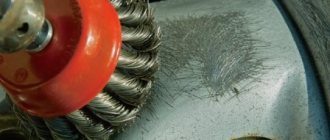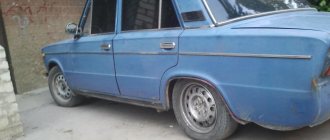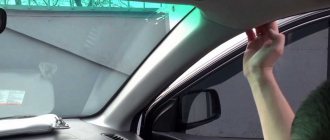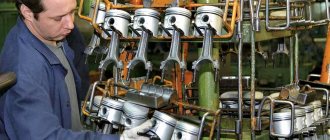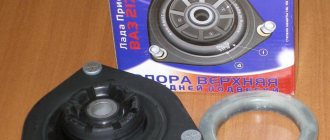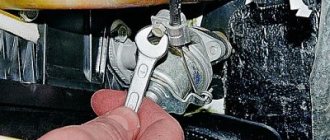During the operation of the car, the wing most often suffers, especially the front one. This happens during a small collision or unsuccessful parking. If the damage is severe, the wing needs to be replaced. It is worth remembering that such parts are not sold factory painted. In addition to the replacement itself, it is also required to paint it in a color as close as possible to the color of the car. And this is an additional blow to the budget if you contact a car service. If you have ever done minor car repairs, then if you have the necessary conditions and tools, you can do the painting yourself.
Painting the wing yourself will cost much less than in a car service
Selection of high-quality and inexpensive material
To paint the wing yourself, in addition to the paint itself, you will need the following:
- putty and primer;
- sandpaper / abrasive material;
- paper tape;
- car varnish;
- clean rags (without small lint);
- polyethylene, pieces of old newspaper;
- dense pieces of rubber (about the size of a palm);
- solvent.
The entire necessary list can be purchased at your nearest hardware store.
The last point deserves special attention. You will need 2 types of solvent. If the amount of work is small (painting one wing), you can purchase them in bulk, which will significantly help you save money.
Features of choosing paint colors
When painting a wing, special attention should be paid to the selection of the color of the paint used. Such a procedure should be carried out strictly in specialized services, where appropriate high-quality equipment is available, and the work is also carried out by specially trained personnel.
Mixing different paint samples makes it possible to get exactly the color you want. To achieve this goal, it is quite enough to simply indicate the one that the manufacturer used. When contacting a car repair shop, specialists may ask to see a small part of the car so that during the coloring process they can constantly adjust for the degree of fading of the coating.
If you can’t choose can paint on your own because the range of colors is not too wide, you should contact professionals who will carry out the color selection process using a special computer program. This procedure costs some money, but the result is worth it.
Painting a vehicle fender yourself is quite easy. If the area to be painted is relatively small and does not exceed more than 50% of the entire wing area, it is worth painting only the problem area. Painting the wing can be done using a can containing paint or using a regular spray gun.
Required Tools
The first step in painting a car fender is to have the necessary tools.
Necessary tools for work
You will need the following set:
- spray gun;
- compressor;
- putty knife;
- planers for cleaning.
What should you consider when painting a wing yourself?
The biggest problem you can encounter when painting a wing is dust. It may not be noticeable to the naked eye, and the garage may seem clean, but when exposed to a spray gun, it rises out of nowhere, subsequently creating a sandpaper effect on the painted fender. Therefore, when painting a car fender with your own hands, you should pay special attention to cleaning the room - thoroughly vacuum and wash the floor.
We paint the new wing strictly in overalls, which should include rubberized gloves and a mask. This way you can minimize exposure to harmful substances when inhaling paint and working with solvents.
Aerosol can device
p, blockquote 4,0,0,0,0 –>
First, it’s a good idea to learn how an aerosol can works and how paint is mixed in it. It consists, in fact, of a container (spray can); a nozzle that fits onto a valve that prevents paint from coming out until you press it; tube located inside the can through which the paint flows to the nozzle. Inside the can there is paint and inert gas.
p, blockquote 5,0,0,0,0 –>
There are aerosol cans with very high quality nozzles, manufactured with high precision. Such nozzles are capable of spraying droplets of the same size.
p, blockquote 6,0,0,0,0 –>
The cans contain a high percentage of solvent. The paint is very liquid. This is necessary so that it sprays normally. Thicker paint would require more pressure to spray. In order to paint with this type of paint normally, without smudges, you need to form many thin layers and dry after each application.
p, blockquote 7,0,0,0,0 –>
Stages of work execution
Painting work includes several stages, which must be performed strictly in the order in which they are indicated. Before you paint a car fender with your own hands, you need to properly prepare it. The surface must be perfectly clean and smooth, without any visible defects.
Before painting the wing, it is necessary to properly prepare it
It is worth not forgetting about workplace equipment. It is impossible to carry out work in poor conditions; the room must be clean and well ventilated. Dust is the main enemy of fresh paint.
Depending on the damage to the fender (scratches, dents or corrosion), the list of work may vary, but there is still one constant rule - the car must first be washed and dried. If the design of the car allows you to remove the wing, then it is easier to unscrew it and paint it separately.
A universal list of painting steps is given below.
Preparing and polishing the wing
Before restoring and painting the wing, it is necessary to carefully sand the damaged areas or the entire part as a whole.
How to grind correctly? You need to start from the places where the filler was previously applied. The abrasive wheel P80 – P180 is designed for them. Next, they move on to medium-grain sandpaper (up to P320) and treatment of the entire surface to smooth out the marks of primary sanding. At the completion stage, proceed to sanding with fine sandpaper. If necessary, stripping is carried out down to metal.
When sanding by hand, you need to apply proper pressure to the surface. Movements should be linear, not circular. Otherwise, large scratches will remain on the surface of the wing.
Sanding the wing before painting
Prime and putty the surface
After sanding, the wing must be puttied, after which the resulting smooth surface with a minimum number of open pores will be obtained. During the puttying process, the wing must also be sanded. To achieve an ideal result, more difficult areas must be sanded by hand.
You can do this as follows:
- Degrease the surface of the wing and apply universal putty.
- After drying, go over the surface with a block or machine with sandpaper from P100 to P320 (depending on the situation).
- Repeat the process until completely leveled.
After puttying, it is necessary to apply the primer with a spray gun in 2-3 layers at a working pressure within 3-4 atmospheres. Adjust the torch so that it resembles the shape of an elongated oval. Before priming, be sure to do a test on a test surface.
Apply layers with a break of 5-10 minutes (until one layer dries). The first layer should be thin, and the second should be denser.
Leave for 24 hours, then sand the top with P500 – P600 sandpaper if the part will be painted metallic.
Puttying the wing before painting
Painting
The painting process itself is much easier than the preparatory stages. Before you start painting, you need to decide how much paint you will need. On average, it takes 150-200 g to paint one wing, if we take test paints into account.
How to paint a car fender:
- Degrease the surface to be painted and wipe dry. If it is not possible to remove the wing, then insulate the surface of the car with newspapers and paper tape.
- Apply the sprayer in 2-3 layers, you must work with it wearing a mask and keep it at a distance of at least 30 cm. You need to wait 10-15 minutes between each layer. Apply until the paint covers all glimpses of the primer.
- Let the paint dry.
Typically, drying times vary depending on the paint used. It is usually indicated on the packaging. For example, acrylic paint dries in about 10 minutes.
Varnishing
The last step in painting the wing is varnishing. The varnish is applied after all layers of paint have dried. It will turn the coating into gloss and protect the paint from rapid abrasion and fading.
The varnishing process depends entirely on the type of varnish used. In addition, weather conditions are taken into account. If varnishing is carried out in winter, the holding time increases significantly.
The process of painting a car wing will not take much time.
If the wing defect is small, then it must be painted and varnished in sections. To avoid the difference between the old coating and the fresh varnish, use a transition solvent, which is filled with a spray bottle and lightly sprayed onto the transition boundaries. This is done if the side edges of the wing are damaged. If the damage is in the center, it is recommended to do a local touch-up and completely varnish the wing, rather than fill all the edges with solvent.
After the varnish has dried, a visual inspection of the wing is carried out. If there are minor defects, the varnish is polished by machine using abrasive pastes. To avoid deviations, it is recommended to strictly follow the painting plan.
Assessing the possibility of self-repair
The first thing we need is to conduct a visual inspection and determine the nature of the defects and damage, assess the correct geometry of the surface being repaired and the need to use putty. If the damage is deep enough, through or requires leveling in the total thickness of the putty layer over 3-5 mm. — it is better to entrust such repairs to professionals, with straightening work. Keep in mind that regular automotive putties can be applied in a layer of up to 2-3 mm, while those reinforced with fiberglass can be applied up to 5 mm. Anything above this thickness will most likely begin to crack and peel very soon.
We do not specifically touch on straightening work, since this is a professional level, and this article is primarily intended for beginners and car enthusiasts. Any, even the most high-quality and durable putty is capable of absorbing moisture and cracking when applied in a thick layer, so you should not overuse it. It is important to understand that the less putty is used when repairing a car, the more professional and long-lasting it is considered. True professionals in their field are able to work miracles and completely restore the geometry of elements with virtually no use of putty.
Now it’s time to decide on the type of paintwork and its color in order to generally understand what we are dealing with. We described in detail how to determine the type of paintwork on a car in this article: Types of paintwork on a car. And to try to accurately determine the color of a car, we recommend reading our article: How to find out the color of a car by VIN.
Please note an important point: there are also so-called “complex” colors. So, if your car color is golden or silver metallic (for example, the Snow Queen), then it will be almost impossible for a beginner to paint such a car and the boundaries will definitely be noticeable. The fact is that this color requires a special approach in order to correctly “scatter” the paint and metallic particles over the surface, as well as “adjust” the tone. Very often this causes difficulties even for “experienced” masters. We strongly do not recommend trying to paint such a car yourself, especially with a spray can.
Recommendations from experts
Do-it-yourself painting of a new wing is done using a sprayer at a distance of at least 30 cm strictly perpendicular to the surface, otherwise the result may be a non-uniform shade.
If painting is done in warm weather, allow each coat of paint to dry for at least 20 minutes before applying another. As a rule, the manufacturer writes detailed instructions for the paint, which you must read before starting work.
Each layer of paint should lie extremely evenly, without smudges. Gaps are allowed only when applying the first layer.
According to the recommendations of experts, to obtain an ideal result after finishing the fender painting work, it is recommended to polish the entire car. This way, the car will look like new, and the freshly painted wing will not be conspicuous by its shine.
Primer for plastic
This primer is used for plastic car parts (bumper, fenders, hood). The mixture usually consists of 1 clear or yellowish component. Suitable for most types of plastic. Some compounds are incompatible with polypropylene.
Primer for plastic
Before applying the primer, the silicone surface of the part is heated (for example, by placing it in the sun) and degreased. Another option is to wash the plastic under hot water and soapy water and dry it. Then apply the adhesive mixture in a thin layer.
Cost of painting a wing at a car service center
The most popular choice is two types of paint - acrylic enamel and metallic. In the first case, purchasing consumables costs around 2000 rubles, and in the second – 2400-3000 rubles.
If you resort to the services of a car service, then painting a car wing costs 2000-2500 rubles. more expensive if you add this cost to the main consumables. This is the case if the damage is not serious. In other cases, painting the wing will cost a tidy sum (about 10,000 rubles). If you've ever had to deal with car repairs and have your hands in the right place, then painting your car fender yourself will significantly save your budget.
Preparing the car for repair
Any repair of a car's paintwork begins with cleaning the surface being repaired and its surroundings. In this case, it is better to completely wash the entire car. Accidental touches or dirt getting onto the surfaces being repaired will certainly ruin the result. Agree that working with a clean car will be more pleasant and easier. The repair area must be especially thoroughly cleaned. After cleaning, it is necessary to protect the elements adjacent to the repair site using a covering film and masking tape; this process is called “masking” and at this stage we will need masking and covering materials. Please note: the protection area must be sufficient to accommodate the deposition of aerosol dust (a cloud of aerosol particles when applying materials).
We work cleanly, protecting neighboring elements.
